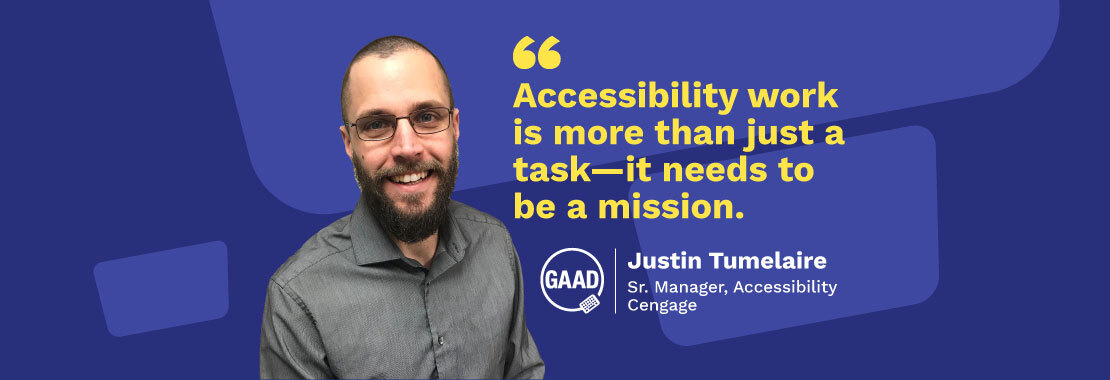Each year, the third Thursday in May marks Global Accessibility Awareness Day (GAAD). GAAD is an opportunity for discussion about digital access and inclusion and commitment to change for the more than 1 billion people across the globe with disabilities and impairments.
Today, as online and hybrid learning continue to increase in higher education, the focus on accessibility is vital. Colleges and universities must rapidly and effectively manage requests from students and instructors who experience any barriers, and fundamentally, ensure their courses are accessible. Thankfully, Cengage has been dedicated for many years to help make eBooks, course materials and learning platforms accessible for all.
In recognition of GAAD, to help raise awareness about accessibility needs and to share key learnings, we sat down with Justin Tumelaire, Sr. Manager for Accessibility at Cengage, to discuss the important and impactful work of his team.
-
Describe your role at Cengage?
In my current role as Sr. Accessibility Manager, my team supports a range of teams across Cengage to ensure our resources are meeting accessibility requirements. From evaluating content and technology, to creating accessible documents, to participating in cross-functional working groups to plan and implement enhancements—all across a portfolio of tens of thousands of digital resources; the work is complex and dynamic, but central to what we do.
Inclusivity is one of our core Learning Design principles. If learning can’t be accessed by all, we can’t achieve our goals, so we must design with accessibility in mind.
-
What motivates you in your work?
Tackling a tough challenge—and there is no shortage of challenges when it comes to accessibility, especially for impacted students. Sometimes, you must be creative in finding the best solution.
I also care about people and people are the central aspect of accessibility. We are all created with dignity and there shouldn’t be barriers to opportunities for ourselves, our knowledge or our skills—or our ability to share these gifts to help enrich the lives of others. Accessibility is about preserving that dignity.
-
How do you feel the culture at Cengage enables accessibility?
Our Credo guides us in our mission, and included in that, is believing in the power and joy of learning and being accountable to and for each other. Everyone is committed to making a difference here. Everyone’s day jobs, be it software development, web design, etc., are busy. They get busier when my team comes with additional work to improve the accessibility of a solution. Still, everyone is on board. They want to make products accessible; they want to make our products available to everyone.
And people are being proactive about accessibility—they want to learn more. Our culture is a big part of that.
-
What are the best parts of your job and what are you most proud of?
Personally, I appreciate the complex challenges this role brings. Given privacy protections, we don’t always get to hear directly from a student about the impact of our work, but I like seeing other people talk about it. The more visibility there is for accessibility, the better. And not just visibility into the challenges a user might face, but visibility around the importance and impact of accessibility. The fact that employees are proactively reaching out to us, asking questions and driving efforts, is great.
Teams also include accessibility as a project requirement, and we have worked hard to “shift left” so accessibility is considered early and often. This is critical to sustained success and I’m proud of our many colleagues who see the importance of accessibility to our customers and the business. I am especially proud of our Accessibility Team. These skilled specialists work tirelessly to advocate for accessibility and are always willing to offer their time helping others to achieve our goals.
-
What are the hardest parts about your job?
The sheer number of stakeholders, processes and teams that are involved with developing any given product can certainly be a challenge. There is no one-size-fits-all technique for making different products accessible. A lot of coordination must happen between different technology teams, content teams and vendors. At times, that can make it challenging to achieve scale, but not impossible.
-
How has COVID-19 impacted accessibility?
COVID-19 highlighted the importance of accessibility more than ever because students who may have had face-to-face support no longer had it, or they had to figure out how to navigate virtually for the support they needed. In a perfect world, everything would be created accessible, but when we face an unexpected challenge like COVID, it really highlights why accessibility is so important. Any company that creates digital solutions must prioritize and strive to develop solutions that everyone can use.
-
What do you wish people better understood about accessibility?
Accessibility work is more than just a task—it needs to be a mission. There are criteria that guide the development of accessible products, but people must be the driving force to make it happen. It’s only possible when we’re conscientious and deliberate in our efforts. Accessibility must not be an addition to workflows, but an integrated part of them.
Also, consider there are things we all take for granted and that there might be individual situations that affect the way people learn. Developing solutions that are accessible helps maximize the learning experience for everyone, but it’s also critical to have a support system in place when a barrier occurs.

